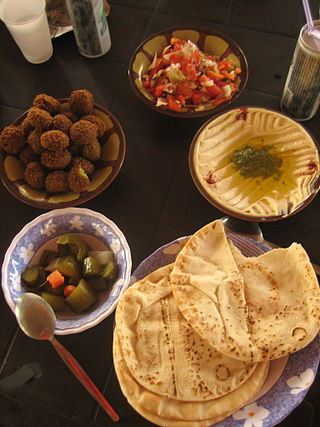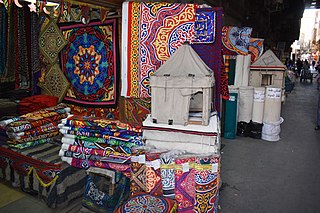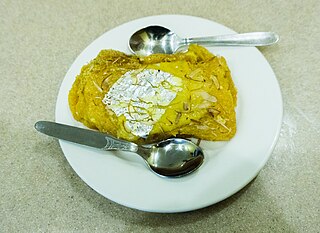
Ramadan is the ninth month of the Islamic calendar, observed by Muslims worldwide as a month of fasting (sawm), prayer (salah), reflection, and community. A commemoration of Muhammad's first revelation, the annual observance of Ramadan is regarded as one of the Five Pillars of Islam and lasts twenty-nine to thirty days, from one sighting of the crescent moon to the next.

Breakfast is the first meal of the day usually eaten in the morning. The word in English refers to breaking the fasting period of the previous night. Various "typical" or "traditional" breakfast menus exist, with food choices varying by regions and traditions worldwide.

Eid al-Fitr is the earlier of the two official holidays celebrated within Islam. Eid al-Fitr is celebrated by Muslims worldwide because it marks the end of the month-long dawn-to-dusk fasting of Ramadan. Eid al-Fitr falls on the first day of Shawwal in the Islamic calendar; this does not always fall on the same Gregorian day, as the start of any lunar Hijri month varies based on when the new moon is sighted by local religious authorities. The holiday is known under various other names in different languages and countries around the world. The day is also known as the First Eid or as the Lesser Eid by some Muslim communities.

Qatar observes several public holidays. The two weekend days are Friday and Saturday, similarly to other Islamic countries. Annual public holidays include:

Haleem is a type of stew that is widely consumed in South Asia, the Middle East and Central Asia. Although the dish varies from region to region, it optionally includes wheat or barley, meat and lentils. It is made by slow cooking the meat in lentils and spices. It is served hot with flat breads or on its own. Popular variations of haleem include keşkek in Turkey, Tajikistan, Uzbekistan, Azerbaijan and northern Iraq; harisa in the Arab world and Armenia; halim in Afghanistan, Iran, West Bengal, in Mauritius, Pakistan and Bangladesh; and khichra in India.

Iftar is the fast-breaking evening meal of Muslims in Ramadan at the time of adhan of the Maghrib prayer.

Suhur, Sahur, or Suhoor, also called Sahari, Sahri, or Sehri is the meal consumed early in the morning by Muslims before fasting (sawm), before dawn during or outside the Islamic month of Ramadan. The meal is eaten before fajr prayer. Suhur corresponds to iftar, the evening meal during Ramadan, replacing the traditional three meals a day, although in some places dinner is also consumed after iftar later during the night.

Arab cuisine collectively refers to the regional culinary traditions of the Arab world, consisting of the Maghreb and the Mashriq. These cuisines are centuries old and reflect the culture of trading in ingredients, spices, herbs, and commodities among the Arabs. The regions have many similarities, but also unique traditions. They have also been influenced by climate, cultivation, and mutual commerce.

The culture of Jordan is based on Arabic and Islamic elements. Jordan stands at the intersection of the three continents of the ancient world, lending it geographic and population diversity. Notable aspects of the culture include the traditional music and clothing of Jordan and interest in sports. These include football and basketball as well as other sports such as equestrianism, fencing, karate, swimming, and table tennis.

Egyptian cuisine makes heavy use of poultry, legumes, vegetables and fruit from Egypt's rich Nile Valley and Delta. Examples of Egyptian dishes include rice-stuffed vegetables and grape leaves, hummus, falafel, shawarma, kebab and kofta. Others include ful medames, mashed fava beans; koshary, lentils and pasta; and molokhiyya, bush okra stew. A local type of pita bread known as eish baladi is a staple of Egyptian cuisine, and cheesemaking in Egypt dates back to the First Dynasty of Egypt, with Domiati being the most popular type of cheese consumed today.

Palestinian cuisine consists of foods from or commonly eaten by Palestinians or in the region of Palestine, whether in Palestine, Israel, Jordan, or refugee camps in nearby countries, or by the Palestinian diaspora. The cuisine is a diffusion of the cultures of civilizations that settled in the region of Palestine, particularly during and after the Islamic era beginning with the Arab Ummayad conquest, then the eventual Persian-influenced Abbasids and ending with the strong influences of Turkish cuisine, resulting from the coming of the Ottoman Turks. It is similar to other Levantine cuisines, including Lebanese, Syrian and Jordanian.

Saudi Arabian cuisine varies according to the diverse landscapes and regions of the country. The environmental, geographic, and cultural diversity within this vast area has led to a wide variety of dishes. Saudi Arabia encompasses different regions, resulting in cuisines from the Central region, Eastern, Southern and Western regions. Furthermore, Saudi Arabia's position along global trade routes has led to the introduction of various spices.

Carlton Hotels & Suites is a Dubai based multinational hospitality company that manages hotels mostly in the Middle East and across Europe. It was founded 1977 with Carlton Tower Hotel in Deira and was the first 5 star hotel in Dubai. The Hotel chain consists of 9 direct managing hotels & 3 franchise operated hotels.

Jordanian cuisine is a Levantine cuisine developed over time in Jordan. Stuffed vegetables are common, with many different techniques employed in their preparation. Meat is an important component of Jordanian cuisine, most often lamb, beef and chicken but also goat and camel meat. Rice is frequently served as a side dish but there are also one-pot rice dishes such as maqloubah.

Khayamiya is a decorative Egyptian art appliqué textile, that dates back to as far as Ancient Egypt. They are now primarily made in Cairo, Egypt, along what is known as the Street of the Tentmakers centered in the Qasaba of Radwan Bey, a historic covered market built in the 17th century. The street is located immediately south of bawabet el metwali, and is located along the historic economic axis of Cairo, in a section within Muizz street.
An Arab television drama or Arab soap opera is a television form of melodramatic serialized fiction. The musalsalat are similar in style to Latin American telenovelas. They are often historical epics about Islamic figures or love stories involving class conflict and intrigue. The word musalsal literally means "chained, continuous".

Shahi Tukra is type of bread pudding which originated in South Asia during the Mughal era in the 1600s. The literal translation of Shahi Tukra is royal piece or bite. Shahi tukre originated in the Mughal Empire when Indian chefs made this dish to present to royal Mughal courts. The white bread is fried in oil/ghee after which milk and sugar is added. The dish is flavored using saffron, cloves, and cardamom.
The Iftar Cannon is an ancient tradition that started in Egypt and spread to several surrounding Muslim countries. Every day minutes before the Maghreb adhan, a cannon would fire a single shot to notify people the time of Iftar in Ramadan, when Muslims get to break their long day fasting as the sun sets.

Furir Bari Iftari is the Bengali tradition among Bengali Muslims in the Sylhet region of giving Iftar to the household of one's daughter's in-laws during the month of Ramadan. The term comes from the Sylheti word Furi (daughter).

Ramadan in the United Arab Emirates has distinctive customs, traditions and rituals. Ramadan is the ninth month of the Islamic calendar, observed by Muslims as a month of fasting, prayer, reflection, and community. Celebrations and preparations for Ramadan begin on the night of the middle of Sha’ban, known as "Haq al-Laila" in the UAE. The month is filled with entertainment, spiritual, and cultural activities and events that tie into the atmosphere of Ramadan.



















